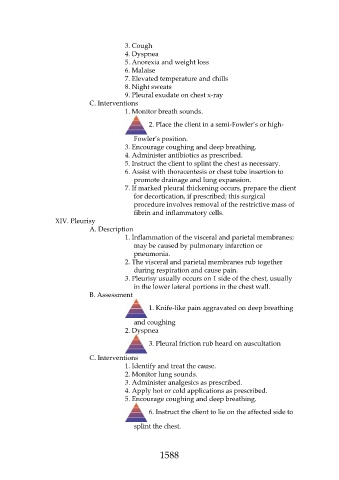Page 1588 - Saunders Comprehensive Review For NCLEX-RN
P. 1588
3. Cough
4. Dyspnea
5. Anorexia and weight loss
6. Malaise
7. Elevated temperature and chills
8. Night sweats
9. Pleural exudate on chest x-ray
C. Interventions
1. Monitor breath sounds.
2. Place the client in a semi-Fowler’s or high-
Fowler’s position.
3. Encourage coughing and deep breathing.
4. Administer antibiotics as prescribed.
5. Instruct the client to splint the chest as necessary.
6. Assist with thoracentesis or chest tube insertion to
promote drainage and lung expansion.
7. If marked pleural thickening occurs, prepare the client
for decortication, if prescribed; this surgical
procedure involves removal of the restrictive mass of
fibrin and inflammatory cells.
XIV. Pleurisy
A. Description
1. Inflammation of the visceral and parietal membranes;
may be caused by pulmonary infarction or
pneumonia.
2. The visceral and parietal membranes rub together
during respiration and cause pain.
3. Pleurisy usually occurs on 1 side of the chest, usually
in the lower lateral portions in the chest wall.
B. Assessment
1. Knife-like pain aggravated on deep breathing
and coughing
2. Dyspnea
3. Pleural friction rub heard on auscultation
C. Interventions
1. Identify and treat the cause.
2. Monitor lung sounds.
3. Administer analgesics as prescribed.
4. Apply hot or cold applications as prescribed.
5. Encourage coughing and deep breathing.
6. Instruct the client to lie on the affected side to
splint the chest.
1588

